The NACS Leadership Forum returned to Miami Beach in February for the first time since 2020 for three days of networking and general sessions packed with insights into some top-of mind challenges and opportunities for convenience retailers, from employee engagement to last-mile technologies to the consumer experience.
The annual invitation-only event brings together retailers and suppliers to explore future-focused ideas and connect with industry peers. Lonnie McQuirter, director of operations for 36 Lyn Refuel Station in Minneapolis and a NACS board member, moderated the 2022 forum.
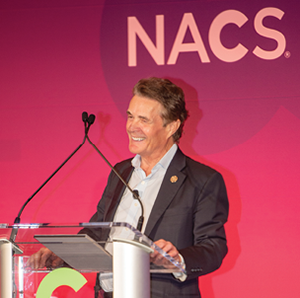 NACS President and CEO Henry Armour welcomed Master of Convenience recipients to the stage.
NACS President and CEO Henry Armour welcomed Master of Convenience recipients to the stage.
INTERVIEW: JIMMY HASLAM
On the opening evening, Henry Armour, NACS president and CEO, and Jimmy Haslam, chairman of The Pilot Company and co-owner of the Cleveland Browns NFL team and the Columbus Crew Major League Soccer team, sat down for a Q&A that sparked a standing ovation when it was over.
“I believe this is a great country if you work hard and get a little luck and have the right people around you,” Haslam said, as he shared how the business grew from a single gas station in Gate City, Virginia, that his father, Jim, purchased in 1958 for $4,000, to a network of about 700 travel centers and 150 dealers across the U.S. and Canada, plus PFJ Energy and an oilfield services business.
“It’s been an evolution,” Haslam said of Pilot, based in Knoxville, Tennessee, and his career. “It’s a great business if you like people, you like a lot of things going on—a lot of action. I tell people all the time that I’ve worked at Pilot 46 years now, and I’ve never had a boring day.”
Armour asked, “What were some of the key inflection points in the history of the company that caused you to pivot a little bit or maybe just accelerate in the direction you were going?”
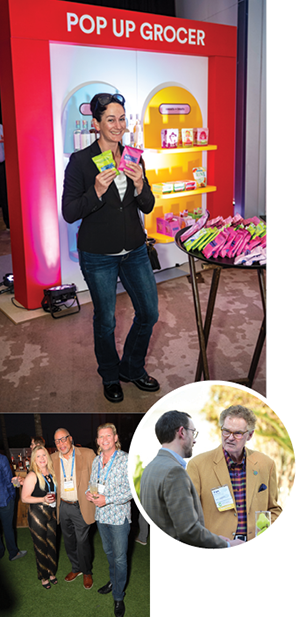 Top: Lisa Dell’Alba, president and CEO of Square One Markets, shows off her finds at an on-site pop-up. The curated assortment of items in trend-focused categories showed firsthand how to drive points of differentiation and memorable experiences.
Top: Lisa Dell’Alba, president and CEO of Square One Markets, shows off her finds at an on-site pop-up. The curated assortment of items in trend-focused categories showed firsthand how to drive points of differentiation and memorable experiences.
Bottom Left: Raymond Huff (center), president of Russell’s Convenience, networks with Clay and Mia Lambert, Metro Petro.
Bottom Right: Van Tarver, chairman, GreenPrint, chats with Tim Venghaus, GreenPrint director of business development.
Haslam offered several key inflection points for Pilot. The first was a 1964 partnership with Marathon. “Marathon at the time was looking for young enterprising people to build up chains of gas stations,” Haslam explained. “They would supply and finance, and then they own 50% and the operator owns 50%.” A key part of the agreement was a deal his father struck that paved the way for either of his then young sons to become CEO in case the elder Haslam stepped aside. Typically, ownership was limited to the current CEO in agreements like this with major oil companies. “That’s why they were never able to buy us out, so it was a really good decision,” Haslam said.
A second inflection point came in 1980 when Haslam and his father visited a “c-store truck stop” in Slidell, Louisiana, that was doing phenomenal fuel sales. The operator, a former football player at the University of Tennessee, where the elder Haslam also had played for the Volunteers, “immediately took to dad, and he was more of a real estate developer not an operator, so he shared everything with us, and we shamelessly copied and built our first truck stop in Corbin, Kentucky.”
Haslam recalled a 1984 business trip with fellow Tennessean Bill Weigel, whose family started the Weigel’s chain of convenience stores. The pair were in El Paso, Texas, with some time on their hands so they drove to New Mexico. “I don’t know which one of us said it—he said he did,” Haslam recalled, nodding at Weigel, who was among the NACS Leadership Forum attendees and is chairman of Weigel’s. “I think we looked at each other and said, you know we haven’t built these things [truck stops] all over the country. And we literally went over there and called on a piece of property in Las Cruces, New Mexico, that we still have today, store No. 266.”
In 1988, Pilot split with Marathon to focus on building a nationwide network of truck stops. Then “in 2000,” he said, “we looked around and everybody in the world was building truck stops,” so the company decided to shift to being a consolidator and asked Morgan Stanley to help find a partner. “Lo and behold, they came back with Marathon, and so that’s what created Pilot Travel Centers,” Haslam said. Rival Flying J went into bankruptcy in 2008, and Pilot eventually was cleared to buy its travel center network to form Pilot Flying J. In 2017, Warren Buffett’s Berkshire Hathaway took a minority stake in Pilot Flying J and will become the majority shareholder in 2023. “What we’ve done well is change,” Haslam said. “Change as the times demand. I think as we look going forward, we’re also going to have to change more than we have in the past to be quicker on our feet and more fluid.”
 Attendees enjoyed being back in Miami Beach and networking in the sunshine.
Attendees enjoyed being back in Miami Beach and networking in the sunshine.
Armour asked Haslam to share some key attributes of a successful leader. Haslam stressed the importance of giving feedback to your teams instead of avoiding conflict. “In football it’s kind of like being tackled. The first time it happens you don’t like it, but the more you do it the more you become better at it,” Haslam said. Don’t demean people, he said, but hold them accountable. Help them become the best person, the best team member that they can be, he said.
“I think just being deadly honest, particularly on really critical issues, and then when there is a coachable moment, coach it right away—don’t wait,” Haslam advised. “That’s something I wish I’d learned a lot earlier in my career,” he said.
One of the things Pilot Company focuses on is “getting the right people in the right place,” which “is the single most important thing a leader can do,” Haslam said. “At Pilot, we talk about being hungry. In other words, we work hard. Humble, which I don’t know how you all are, but I value humility way more than I used to,” he said. “Humble, hungry, accountable and then commercial. We’re not doing this for the hell of it as you say, we’re doing it to make money. Not everybody has to have commercial skills, but a certain percentage of the organization does...Where we fall short is we don’t always hire like that. You don’t have to be four for four, particularly at certain levels, but you can’t be one for four. So, if you want to have that kind of culture you have to hire into that image.”
Facing the Labor Shortage
McKinsey & Company partner Alex Rodriguez, and associate partner Annie Valkova, dove into data indicating why employees choose to leave their jobs, what employers think are the reasons for the resignations and what would make employees stay on the job in the Thursday morning session, “The Great Attrition: Facing the Labor Shortage Challenge,” at the 2022 NACS Leadership Forum.
It comes as no surprise to retailers that the pandemic accelerated macro trends like connectivity, automation and societal shifts in expectations of businesses and lifestyles. “People are thinking about work and life differently, and there’s a newer generation coming up that wants to be an active part of the conversation around what companies are doing,” Rodriguez said. “This sets the stage for what we’re seeing in labor in general.”
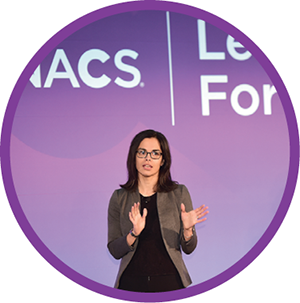 Annie Valkova, associate partner, Chicago, McKinsey & Company, shared data behind the “Great Attrition.”
Annie Valkova, associate partner, Chicago, McKinsey & Company, shared data behind the “Great Attrition.”
In a McKinsey survey conducted in August 2021, 36% of retail employees polled indicated that they had quit their jobs without another one lined up within the prior six months, and 64% of those surveyed said they were at least “somewhat likely” to quit without a job offer within the following 3 to 6 months. The results, Rodriguez said, are “pretty shocking.” People are quitting their jobs at “unprecedented levels, which is further compounded by the fact that job openings are growing at a faster pace, so this is in essence the perfect storm.”
Relational aspects of work are the primary factors that influence employees to stick with their jobs or find new ones, McKinsey research shows. What’s most important to employees? Feeling valued by the organization and their manager, a sense of belonging and work-life balance. What’s only somewhat important? A safe environment, doing meaningful work, access to technology and the ability to work autonomously. For these employees, caring and trusted teammates, flexible work schedules, potential for advance and inadequate compensation rate as somewhat important factors.
Employers surveyed, however, rate transactional factors as the most important reasons by employees leave their jobs—things like flexible work schedules and development opportunities. So, there’s a mismatch between what employees and what employers think is important in terms of job satisfaction.
There are three ways to flip the dynamic:
1.) Build a culture that values employees as whole people. Organizations with a strong culture outperform their peers.
2.) Make the day-to-day job simpler and more engaging. Many retail processes could be more efficient via automation.
3.) Commit to upskilling and reskilling employees to help retain them, including things like paid tuition, on-demand micro-training and role progression.
Winning Over Teams
In “Build a Winning People Strategy,” Erin Pressley, NACS vice president, education and media, moderated a discussion among HR executives from leading convenience retailers. The panel included Shelly Gibson, chief legal and people officer, Thorntons; Seth Kamen, vice president of talent management, EG America; and Jamie Landis, vice president of team member experience, The Pilot Company.
At EG America, Kamen said, “the challenge that we face is much bigger around retaining talent than finding talent.” Gibson of Kentucky-based Thorntons agreed about challenges retaining employees but also hiring new ones. “It’s taking twice as many applicants in many of our geographies to actually fill an open position,” Gibson said, and “we can’t get some of them to come interview. A lot of them are ghosting us daily in higher numbers than ever before.”
 “Build a Winning People Strategy” sparked discussion among HR executives from leading convenience retailers. L to R: Jamie Landis, vice president of team member experience, The Pilot Company; Seth Kamen, vice president of talent management, EG America; Shelly Gibson, chief legal and people officer, Thorntons; and Erin Pressley, vice president of media and education, NACS.
Pressley asked the HR pros, “What specific steps are you taking to stem the tide?” Landis said Pilot has homed in on the onboarding experience. “If we get the first two weeks right, that correlates to them staying for at least 30 days. If we get over 30 days, the likelihood of staying for 90 increases, and if we get them for 90 it’s good,” Landis said. Pilot assigns new team members a buddy, holds regular check-ins and makes sure that managers “protect those two weeks” on the job.
“Build a Winning People Strategy” sparked discussion among HR executives from leading convenience retailers. L to R: Jamie Landis, vice president of team member experience, The Pilot Company; Seth Kamen, vice president of talent management, EG America; Shelly Gibson, chief legal and people officer, Thorntons; and Erin Pressley, vice president of media and education, NACS.
Pressley asked the HR pros, “What specific steps are you taking to stem the tide?” Landis said Pilot has homed in on the onboarding experience. “If we get the first two weeks right, that correlates to them staying for at least 30 days. If we get over 30 days, the likelihood of staying for 90 increases, and if we get them for 90 it’s good,” Landis said. Pilot assigns new team members a buddy, holds regular check-ins and makes sure that managers “protect those two weeks” on the job.
Gibson shared that in addition to its long-standing first 90-day guidebook that every new hire must consult, Thorntons is working on a program rolling out this spring to zero in on the most crucial things for new employees to learn during their first 90 days and incentivize the training so it gets done. Thorntons conducted its first-ever companywide engagement survey in December 2020, which it used to set organization priorities in 2021 and help teams measure their progress toward the goals. The participation rate was about 77%, including front-line store staff, Gibson revealed. “Everybody was excited that we were doing the engagement survey and wanted to participate in the rollout,” she said. “For some of our team members, that was the first time that anybody had truly asked them for feedback in a working environment.”
At Pilot, Landis said, “we spend time with the front line. “What do you need from us? What’s getting in the way? Sometimes it’s as simple as a program or policy change,” she said, “but sometimes it’s fundamental, and there’s some operating model things that need to shift, whether it’s the labor model or whatever the case may be. I think it starts at listening. Meeting people where they are and getting some quick wins to build momentum, so they feel heard. They feel a part of the process because they are part of the process.”
EG Group, which has been fast acquiring companies, conducted an engagement survey last year across all of its units worldwide, Kamen said. “This year, one of our strategic priorities is building the engagement of the team, continuing to identify what are we doing well, what are our opportunities and how do we continue to build on that?”
Tips from the panel for enhancing workplace culture include: Communicate organizational priorities, celebrate wins, make people feel cared for by listening and taking action when they offer feedback, and share positive steps toward meeting goals.
The three convenience retailers are using technology in various ways to connect with and engage employees. Kamen mentioned that EG America has an internal social media channel and mobile app so employees can share within the company. Pilot employees at the store level and in the field have an app on their phones that allows them to access micro-learning modules on demand and do things like check in for their shifts and recognize fellow team members, Landis said. One way Thorntons is embracing technology is by using self-checkout stations, which frees up team members to do other tasks in the store.
The Digital Path to Purchase
Lori Stillman, NACS vice president of research, presented “Showing Up When It Matters Most: The Role of Digital in Convenience Retail.” Stillman outlined why it’s important that retailers pay attention to their digital listings because the customer journey has transitioned away from a linear model to one in which consumers are processing multiple channels of information, starting with digital discovery.
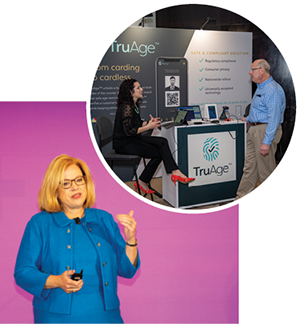 Top: The digital age-verification system TruAge added another supporter (Reynolds American) to its roster.
Top: The digital age-verification system TruAge added another supporter (Reynolds American) to its roster.
Bottom: Lori Stillman, NACS vice president of research, explored how to help customers find convenience retailers along the digital path to purchase.
“Most of the tools that we use today are different because they’ve become digital… Digital is here to stay, and it is what customers are looking for when they’re looking to fulfill the things that they want,” Stillman said.
The pandemic sharpened this shift. Accenture surveyed shoppers and their digital habits and found that “their preference to interact with retail is to start with the digital channel,” Stillman said.
In a Facebook study conducted last year across 17 countries, 66% of shoppers surveyed said they use online research or online resources before they go into a physical store. “The relationship between search, social and ratings and reviews becomes how you show up locally when and where people are looking,” she said.
At a basic level, show your area of expertise via your local profile. Make sure your Google business listings are current, consistent and accurate. Each business should have its own local landing page. “Take ownership of every single Google My Business page about your business. You need to claim your business as yours before somebody else days and starts to control the information about your business,” Stillman said.
“Second, if you have social media accounts for your brands, for your banners, for your businesses, make sure somebody is taking care to ensure that they’re current and consistent,” she said. “Are the comments that people are making about your business appropriate to your business? And if no one is commenting, do something to get people to start commenting on your business. Ask customers, hey did you have a great experience? We’d love it if you would go on Yelp! and just talk. You’ve got to make sure you’re responding to those reviews and ratings.”
(Read more about search and local listings in the February issue of NACS Magazine.)
REACHING CONSUMERS
On Thursday, Ben Kipfer, chief operating officer, Choice Market, and Raghu Mahadevan, chief digital officer, 7-Eleven, shared how their respective companies approach customer needs in “Meeting Consumers Where They Are.”
Denver-based Choice Market, which has four locations, is creating a technology-centric network of what it dubs convenient, small format markets and last-mile fulfilment centers that offer high-quality, local products, with an emphasis on better-for-you food that aligns with the environmental and social values that its core digitally connected customer base embraces. “We are really focused on reinventing convenience and convenience stores,” Kipfer said. “When I describe Choice to my friends and family, I often say, imagine Whole Foods assortment meets a Sweet Green or Chipotle all wrapped in a 7-Eleven space.” There are four different store configurations tailored for different neighborhoods: urban market, suburban mobility center, autonomous mini-mart in nontraditional retail spaces and smart vending machines for campus environments.
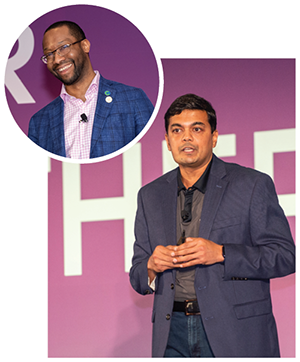 Top: Lonnie McQuirter, director of operations, 36 Lyn Refuel Station, moderated the 2022 forum.
Top: Lonnie McQuirter, director of operations, 36 Lyn Refuel Station, moderated the 2022 forum.
Bottom: Raghu Mahadevan, chief digital officer, 7-Eleven, shared how the retailer meets customers where they are through a focused digital strategy.
The shift in consumer demand that the pandemic accelerated is an opportunity to rethink what the c-store can and should be, Kipfer explained. E-commerce accounts for about 30% of Choice Markets’ business today, and the retailer is investing heavily in technology to continue to grow its digital business.
Kipfer shared two of the challenges Choice faces as a small startup. The first is, “We have more data right now than we could possibly know what to do with,” he said. With the help of some partners, Choice is looking at external consumer data, internal customer data, financial data and operational data to “support more real-time and robust decision-making to help us improve our daily business and also help us to scale,” Kipfer said. “The second challenge is upskilling our workforce,” he said, which ties into leveraging new in-store technology to better meet consumer demand.
Choice takes a multipronged approach when it comes to meeting customers where they are. There’s an app with shoppable recipes and a personalized loyalty program, buyonline-pickup-in-store services, self-checkout, a new autonomous format, third-party delivery, own-store delivery via electric vehicle and Tortoise autonomous delivery.
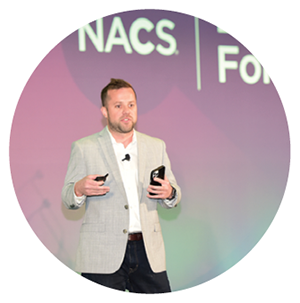 Ben Kipfer, chief operating officer, Choice Market, described how Choice Market weaves technology into its operations.
Ben Kipfer, chief operating officer, Choice Market, described how Choice Market weaves technology into its operations.
“We do a lot of work and sales on third-party platforms,” Kipfer said, including Uber Eats, DoorDash, Grubhub and Chowhound. “We have the opportunity to turn on and off delivery for an Uber Eats order, for instance, so I can say, hey, we’re going to go ahead and do this delivery because it’s going to save us a significant amount of money on that transaction because they’re taking quite a bit off the top,” he said of the fees third-party delivery providers charge c-stores and restaurants. “We are looking at investing in new tools that allow us to do smart routing so that we will be able to look at whether it’s a native delivery order for us, and we can go run it in our vehicles with our team members based on labor, based on distance, based on, is this a current customer?” The technology will help Choice manage costs around delivery.
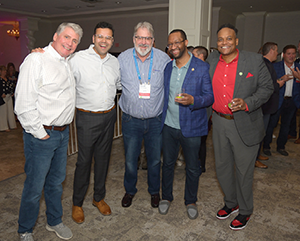 L to R: Gray Taylor, Conexxus executive director; Jigar Patel, Fish River Food Mart; Geoff Wigner, Nashville Display; Lonnie McQuirter, 36 Lyn Refuel Station; and Derek Gaskins, Yesway, reconnect at the forum.
L to R: Gray Taylor, Conexxus executive director; Jigar Patel, Fish River Food Mart; Geoff Wigner, Nashville Display; Lonnie McQuirter, 36 Lyn Refuel Station; and Derek Gaskins, Yesway, reconnect at the forum.
7-Eleven is the largest convenience retailer in the U.S., and like Choice Market, is heavily focused on digital innovation. The Texas-based company has more than 13,000 c-stores serving 12 million customers a day across the U.S. and nearly 80,000 locations worldwide. Mahadevan reminded the audience of 7-Eleven founder Joe Thompson Jr.’s motto: “Give the customer what they want, when and where they want it.” Today that’s become “Be the first choice for convenience. Anytime. Anywhere.” The customer, Mahadevan said, is always at the center.
7-Eleven’s digital journey began in earnest in 2015 with a “very conscious investment in trying to meet the customer where they are as they move forward,” he said. What followed was the drawing together of a worldclass digital technology team that paved the way for custom-built technology powering a relaunched app with the Seven Rewards program, the launch of contactless payments and ramped up R&D efforts.
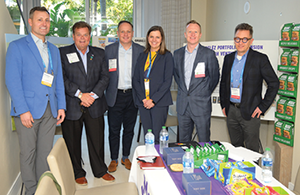 Top-to-top meetings between NACS Hunter Club members like Mondele-z International and leading retailers are a key component of the event.
Top-to-top meetings between NACS Hunter Club members like Mondele-z International and leading retailers are a key component of the event.
From 2019 to the present has seen the launch of 7NOW delivery, mobile checkout and fuel loyalty and 7-Eleven Wallet, which allows cash customers to load funds into their digital wallet and use all of the features in the digital ecosystem. The latest innovation is an autonomous store featuring 7-Eleven’s own proprietary technology in a company store-support center in Dallas. “The store can handle beverages, hot food—everything,” Mahadevan said. “Customers walk into the store, leave the store and everything is seamless,” he shared.
A new Gold Pass subscription for $5.95 a month gives subscribers access to free deliveries, double rewards points, free products and more. “I think it’s one of the best out there for the value it gives for our customers,” Mahadevan said.
When it comes to delivery of convenience items, customers want their food and drinks delivered fast. “7NOW is the 7-Eleven store to your door in just a few minutes,” Mahadevan said. “We currently cover 95% of our footprint, and it’s 95% because there are really some stores where it’s very hard to find drivers around those stores,” he said, touching on a labor pain point that nearly all retailers face. He noted that basket size for delivery is at least two or three times as big as in-store baskets.
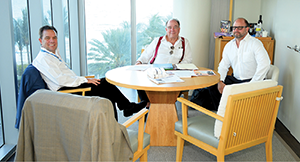 Afternoons included time for NACS Hunter Club members and retailers to connect.
Afternoons included time for NACS Hunter Club members and retailers to connect.
Along its digital journey, 7-Eleven has learned the importance of real-time inventory to keep its product substitution rate low. “If you’re showing your product to the customer and it’s not going to be there, you can go through a lot of substitutions on the back end, but you’re still not giving the customer the choice that they wanted,” the 7-Eleven COO said. So, 7-Eleven added real-time inventory capabilities “so if a product is not there it doesn’t show up” in the customer’s app. That also means building best-in-class “pick-pack operations” enabled in part by a 7HOUR tablet “to make it as seamless as possible for our store operators to fulfill on the delivery product.”
IMMERSIVE RETAIL
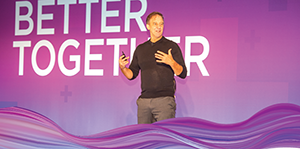 David Bell, founder of Idea Farm Ventures and former professor of The Wharton School, University of Pennsylvania, discussed how to design and deliver customer-focused, immersive retail.
David Bell, founder of Idea Farm Ventures and former professor of The Wharton School, University of Pennsylvania, discussed how to design and deliver customer-focused, immersive retail.
On Friday, David Bell, founder of Idea Farm Ventures and former professor of The Wharton School, University of Pennsylvania, shared “How to Design and Deliver Consumer-Resonant and Immersive Retail” to close out the NACS Leadership Forum at the Eden Roc in Miami Beach. Using case studies from Diapers.com, Warby Parker and Harry’s, among others, Bell showed how retail has evolved across three waves: location of stores (brick-and-mortar), location of customers (e-commerce) and location of activities (omnichannel).
“A big mistake that a lot of people made 20 years ago was that digital and e-commerce would eat this and that—it’s going to kill physical. But of course, that’s completely not true,” Bell said. What’s interesting, he said, is that companies that started first with brick-and-mortar stores—like Macy’s—often stumbled when launching e-commerce in part because the digital side was treated as a separate business and wasn’t properly integrated into the company.

He offered a framework for deploying retail in an omnichannel environment. “Whether you’re a department store or supermarket or convenience retailer, two fundamental things have to be delivered to customers. No. 1: We have to be able to give customers information about what we sell. What are the prices? What are the brands? What are the elements, the customer service, the terms of trade and everything else? And No. 2: We have to be able to fulfill product. We’re going to get them stuff. We’re going to take returns if they need returns.”
The idea of customers buying goods online and then picking them up in store or curbside took off during the pandemic. “Everybody had to integrate the inventory management system into the website so that you could show people what you actually had in stock,” Bell said. “That’s opened up interesting possibilities for delivery companies and everything else.”
When people are in physical stores, they crave engagement and experience—and will share it through their own spheres of influence. “Your audience has an audience,” Bell said. “Today, if you have a fantastic operation and 100 people come in, maybe 10,000 learn about it. Because when people come in, they create content, and they share and upload content.”
Now, retail can be everywhere, and everything is shoppable. Bell pointed to a Los Angeles company that sells outdoor furniture, and one of the ways it markets its brand is by incentivizing customers to transform their backyards into showrooms where strangers can stop by and check out the products. “Think about the power of retail happening in places other than stores and other than e-commerce,” Bell said.